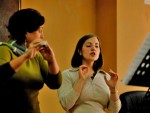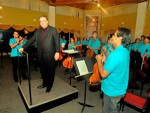Title
Great social movements usually begin with the inspiration and hard work of a few—individuals who heroically bring about positive change in their community. The American civil rights movement, Solidarity, and India’s struggle for freedom are prime examples. These movements invariably try to address the needs of the poor, disenfranchised members of society and require great sacrifice by their champions. Often these “saints” come from the more privileged ranks of society and eschew their comfortable station for higher purposes. Puzzling at first, or even troublesome, their ideas eventually take on a self-evident quality as the resulting benefits change—or reaffirm—the deepest values of the societies they serve.
Body
Juilliard joined such a movement this past March when three musicians—doctoral student Toni Marie Marchioni (oboe), master’s student Alexander Kienle (horn), and I—travelled to Quito, Ecuador, to work with Sinfonia por la Vida, a program of social inclusion through music that promises to become an important part of the cultural fabric of that country. Our trip was the result of a meeting in early 2009 between Juilliard President Joseph Polisi and three of the Sinfonia’s founders: music director Patricio Aizaga, executive director Maria del Carmen Araujo, and international coordinator Albert Hunt, a Juilliard alumnus.
Run by Fundación Orquesta Sinfónica Juvenil del Ecuador or FOSJE, Sinfonia por la Vida (Symphony for Life) is heavily influenced in its design by Venezuela’s Il Sistema. Though in its infancy, it is already making an impact in Ecuador. It has three levels: a professional orchestra (Orquesta Filarmónica del Ecuador), a youth orchestra, and an orchestra for young children. In a country of modest means, it is impressive that FOSJE has the protection and support of the government in the form of stipends for the musicians as well as meaningful educational support for the students, who come from modest or impoverished socio-economic situations. The FOSJE team was seeking a relationship with Juilliard to help the program grow and prosper. FOSJE wanted to explore ways to help its senior musicians become more effective, more artistic teachers. Maestro Aizaga believes each generation benefits from the hard work of the previous one. He is building a “cultural wisdom” into the culture of Ecuador in which art music enlightens the mind to life’s possibilities.
A conductor of international renown, Aizaga has conducted throughout the Americas, Asia, and Europe and has received awards from Unesco for his dedication to youth. He is the artistic vision and soul of FOSJE. Maria del Carmen Araujo provides its heartbeat and lifeblood. She tirelessly raises funds and lobbies for support for FOSJE both within Ecuador and the United States. Formerly of the World Bank, she is driven and persuasive. Her close advisor Albert Hunt (M.M. ’84, D.M.A. ’86, clarinet) says, “With her background, Maria del Carmen could be making a significant salary in the financial world. She chooses instead to help her country’s citizens prosper in a different way. She has taught me a new form of patriotism.” Hunt spends much of his time in Quito giving master classes throughout the country. When he is in the U.S., he divides his time between teaching and performing in Washington, D.C.
We arrived in Ecuador in the late evening on Sunday, March 8. Early the next day, we met to discuss our plan for the week and began working with the musicians. Our original agreement called for about six hours of work each day. The desire and enthusiasm of the FOSJE musicians was infectious and we all ended up working much longer hours. Between rehearsals, master classes, and private lessons, there wasn’t much time for sightseeing, but they were the sight to see. Even during lunch, Marchioni and Kienle were asked to hear “one more excerpt” or discuss some aspect of brass or double-reed playing. These musicians are anxious to absorb anything that can help them better understand the craft so they can better express the art. I rehearsed all three orchestras and gave a performance with them on Friday evening. Each orchestra is impressive and has a culture of peer dedication and encouragement that drives their musical efforts. We departed the next morning at 6 a.m., exhausted but edified.
Hunt observed the entire week and said, “How amazing to watch this exchange. For the Ecuadorians, the musical progress in just a few days was profound. They thoroughly appreciated what they learned. And the Juilliard visitors witnessed the refreshing enthusiasm of the students and young professionals. The experience reminds us of why we became musicians in the first place.”
St. Francis of Assisi once said, “Start by doing what’s necessary; then do what’s possible; and suddenly you are doing the impossible.” In Quito, one main square in the city is dedicated to this saint who started his own movement so many centuries ago. Sinfonia por la Vida’s movement of social inclusion through music turns these ancient words into current action. Bravo!






